|
CROSSING the busy road at a traffic light to two huge rust red buildings forming a great backdrop to Manege Square. These buildings were the War Museum and the State Historical Museum. It was the sort of place where you could spend days exploring the 4.3 million exhibits. The buildings had white towers. They occupied the site where the Principal Medicine Store commissioned by Peter the Great once stood. It was demolished and replaced by the existing buildings in 1872.
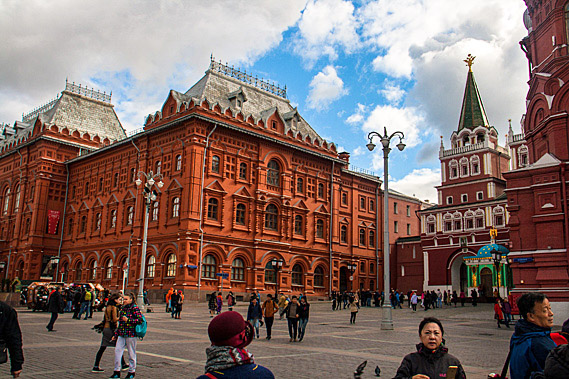 |
The museums |
Outside the museum were numerous stalls all set up as part of the harvest festival. Manege Square would have been rather drab without them, but they sent brilliant colours blending in very well with the national museum.
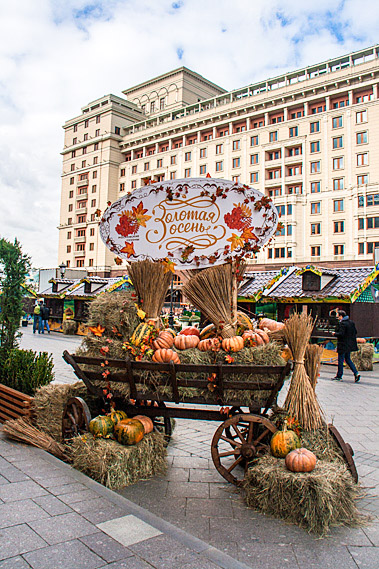 |
Harvest festival |
A large statue of a horse and rider stood outside the museum. This was the Marshal Zhukov monument. He was a Soviet Red Army officer who became the Minister of Defence during World War II, commanding the Belorussian Front in the Battle of Berlin, resulting in the defeat of Nazi Germany ending World War II in Europe, and the last of the historic invasions of Russia.
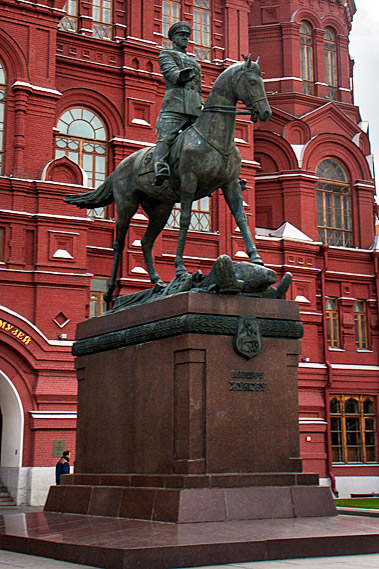 |
Marshal Zhukov |
We headed through the stalls. Pavel pointed out a large sandstone coloured government building with the main road passing it. He said at one point the road was widened and the entire Savvinskoye Podvorye building had to be moved several metres to allow for its widening. Most buildings on the street were demolished to allow the widening, but this one was moved.
 |
Building that was moved |
A gap in the clouds appeared showing blue sky, and for a few moments the sun shone through. We had passed the harvest festival stalls and now heading towards a large dome with a bronze horse and rider on top of it and fountains. Apparently, there was a large shopping centre underneath us, with the dome marking its centrepiece.
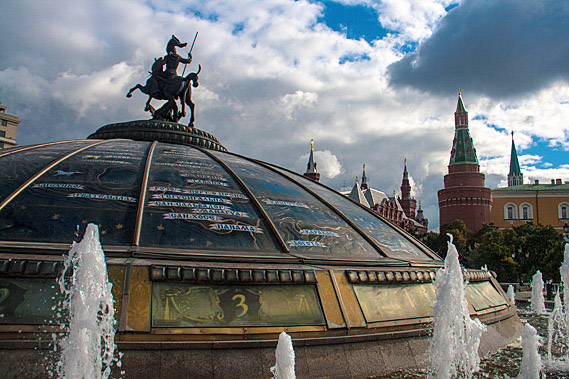 |
Dome over the mall |
Approaching the dome, the top of the bronze horseman’s head had a crow sitting on it. The dome had the names of cities written on it. Continuing along the top of the shopping centre we passed a few more fountains. Streams flowed through the marblework. Along the artificial stream were numerous statues of different animals. A garden lay on the other side of the stream.
 |
Horses on the dome |
The stream widened with several marble bridges crossing them and several fountains creating a spectacular layout as we approached the entrance to the Kremlin. The biggest of these fountains had several horses all raised on hind legs. In front of them were large fountains of roaring water.
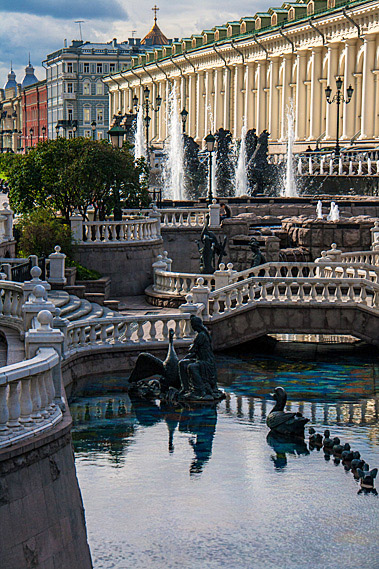 |
Fountains and stream |
Crossing one of the bridges, we reached Alexandrovsky Garden. It was perfectly manicured with beautiful flower beds brightly coloured with brilliant greens, reds and whites lifting the otherwise drab conditions.
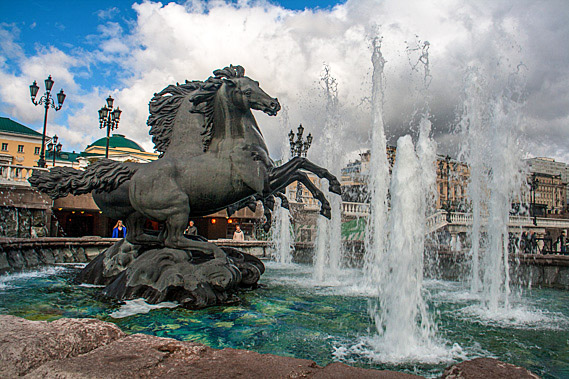 |
Horses and fountain |
The ten-hectare garden was constructed as part of the restoration of Moscow following the war with Napoleon Bonaparte’s French army in 1812. Over four years the Kremlin Garden (as it was called) was constructed. It was not until 1856 was it given its modern name, Alexandrovsky Garden, in honour of Russian Emperor Alexander I. Divided into three sections, the garden connected the Kremlin to the city.
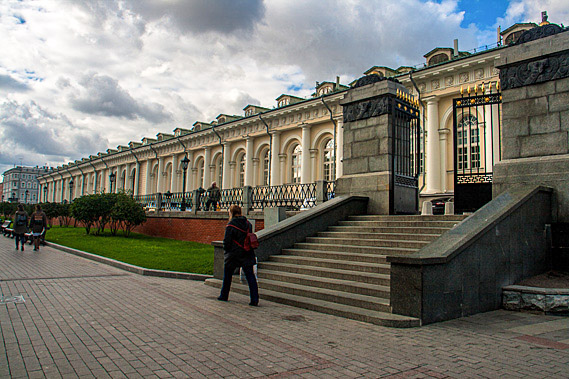 |
Alexandrovsky Garden |
The garden continues to thrive today with over 800 trees and 4000 ornamental bushes growing here around the equally manicured lawns.
 |
Fountain stream |
Heading towards the great wall of the Kremlin, looking into the gardens I could see the gold and white spires of the palaces and cathedrals. The wall coming across the side of the park stood about eight metres high with fancy battlements running along its top. Just behind the wall was a large building standing three storeys high, with very tall ceilings. These were some of the government buildings within the Kremlin.
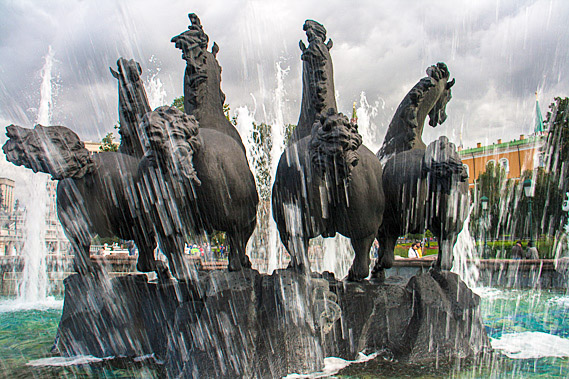 |
Horses in fountain |
Looking ahead was one of the towers. Nearby stood a concrete obelisk with a small golden statue on top of it. Nearby along the wall stood a red tower. The tower itself wasn’t significant, but along its base was what looked like the remains of a broken wall. It was a collection of relics collected from the rubble of the city following the Napoleonic war, all carefully set in the concrete. Romanovsky Obelisk (built in 1914 celebrating the 300th anniversary of the Romanov Dynasty.) and Srednyaya Arsenalnaya Bashnya, a tall red tower with broken bits of rubble at the bottom.
 |
Romanovsky Obelisk |
We continued following the wall back towards the national museum. A green lawn and low coniferous trees separated the wall from the wide path. The grass ended in a large area of stepped paving leading up to a large platform area of large reddish pavers. In the middle of the paved area was a small pond with a flame rising from its middle.
 |
Tomb to the Unkown Soldier |
On either side of the flame was a small glass shelter with a soldier wearing black in front of it. In between the soldiers behind the flame was a low bronze statue.
 |
Standing guard |
This was the tomb to the unknown soldier, a memorial to past wars. In front along the path were a number of stone blocks, each naming one of the many wars Russia has fought in recent centuries. At the far end was the last war, the 1941 to 1945 World War II when Nazi Germany invaded. From there each block listed the wars going progressively back in time.
 |
Eternal flame |
We were just in time for the changing of the guards, an event that happens on the hour every hour since the tomb to the unknown soldier was opened shortly after the end of the World War II.
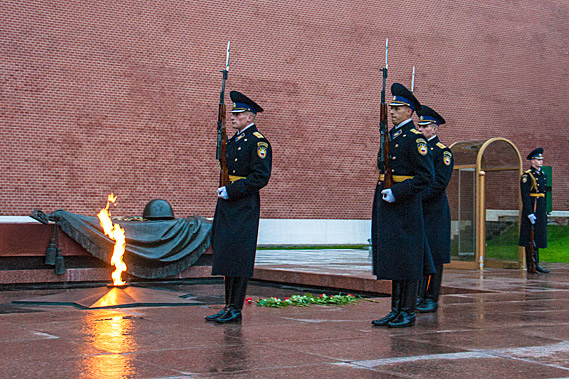 |
Hourly changing of the guard |
The guards had changed whilst we were walking through the gardens, but Pavel told me they change every hour on the hour and have done so for decades since the tomb to the unknown soldier was opened. The soldiers stood forward, perhaps relieved to be allowed to move after standing perfectly still for an entire hour.
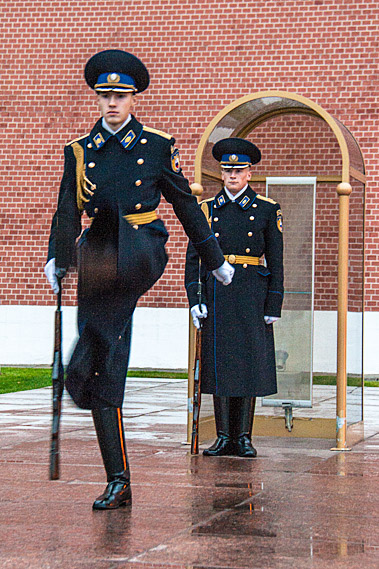 |
Changing guards |
Three more soldiers appeared out of a door into the great wall of the Kremlin. In perfect formation, they marched with huge strides raising each leg horizontal hardly wrinkling their perfectly tailored and pressed uniforms. They marched to the other three soldiers, took their place. Then the original three soldiers marched off in perfect formation heading to the same door the new soldiers came out of. Once the changeover was complete, the soldiers who had been standing around the tomb will be able to rest for perhaps the hour before they would have to come out again.
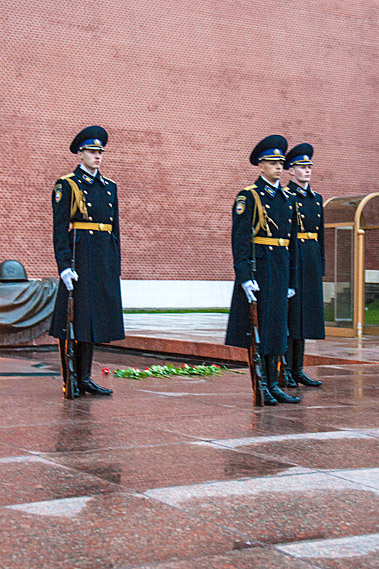 |
Changing guards |
The weather was rather cold, but otherwise reasonable conditions for them to stand out here. Day and night. they guard the tomb. They had glass arched shelters to stand under should it start raining or snowing. The winters here are quite brutal with many days not rising above freezing. It must be pretty tough for them to be standing out here like this, guarding the tomb and overlooking Alexandrovsky Garden. At least the view is good.
|
